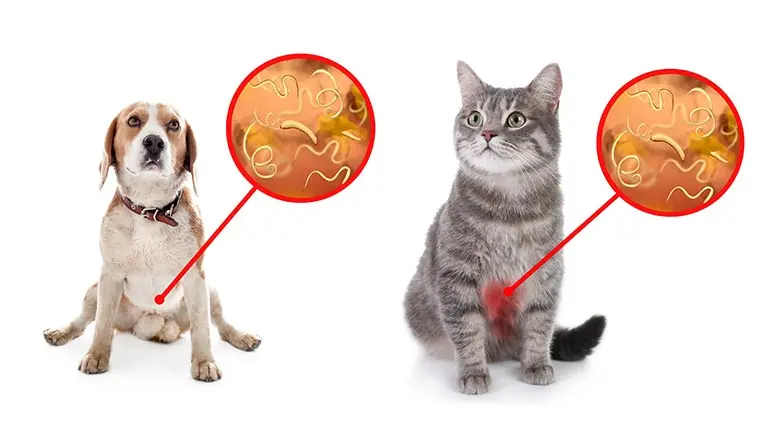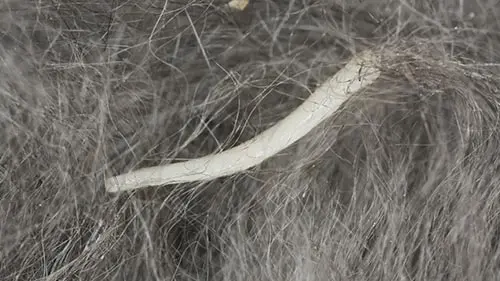One of the Least Savory Aspects of Pet Ownership That You May Not Know About
This can be an invisible issue but it can cause symptoms in your dog or cat like vomiting, weight loss, diarrhea and poor coat condition. But it also may not cause any noticeable symptoms at all.

STORY AT-A-GLANCE
- Intestinal worms are relatively common in dogs and cats
- Four of the most common types are hookworms, roundworms, tapeworms and whipworms
- If you suspect your dog or cat is dealing with an intestinal worm infestation, prompt diagnosis and treatment will assure the best outcome
- Treatment should be targeted to the specific identified parasite; combination dewormers, especially those given monthly, should be avoided
Editor's Note: This article is a reprint. It was originally published December 17, 2016.
There's a not-so-pleasant aspect of pet parenting that most of us are familiar with (and wish we weren't!) — the dreaded intestinal worm infestation. There are actually several types of worms that can wriggle their way into your dog's or cat's GI tract, including the hookworm, roundworm, tapeworm and whipworm.
How Do I Know If My Pet Has Worms?
The short answer: it can be challenging. Some intestinal worms can be seen with the naked eye; others can't. Dogs and cats with worm infestations may have one or more of the following symptoms:
- Diarrhea that may or may not be bloody
- Vomiting
- Weight loss
- Poor coat condition
However, sometimes the presence of intestinal worms causes no noticeable symptoms. The worms can also lay dormant in your pet's body for long stretches. The following is a short primer on four common types of intestinal worms.
Hookworms
Hookworms attach to the intestinal wall and suck the blood of the host. They're much more common in dogs than cats.
Hookworms are primarily transmitted fecal-orally to animals, meaning your dog or cat may eat contaminated feces or dirt, or he might walk through contaminated soil, then lick his paws and ingest the eggs. Puppies and kittens can acquire hookworm from an infected mother's milk.
A puppy or kitten who acquires hookworms can become lethargic, weak, malnourished and anemic. It isn't uncommon for young pets to die from a hookworm infestation.
Infected adult pets may show symptoms of poor appetite and weight loss. Chronic hookworm infestation is a common cause of illness in older dogs.
Humans can also acquire a hookworm infection, typically by picking up the eggs or larvae on the skin from soil contaminated by infected wild animal or pet poop. Hookworm larvae have the ability to penetrate human skin, and they aren't visible to the naked eye.
To prevent a hookworm infestation, it's important to get rid of any potentially infective feces from wild or stray animals around your property that might tempt your dog or cat. It's also a good idea to keep your pet away from the poop of other animals while you're walking outdoors or hiking.
Roundworms
Roundworms are large and spaghetti-like in appearance, and they can create a full-blown infestation in your pet before you even know they're there. By the time you see signs of roundworms in your dog's or cat's feces or vomit, he's overrun with them.

It's important not to wait until you actually see the worms to alert you to an infestation. If you suspect your dog or cat has been exposed, you should collect a stool sample and drop it by your veterinarian's office for analysis.
Pets typically acquire roundworms by eating infected feces. The infection can also be passed from a female to her unborn litter across the placenta. The pups or kittens develop their own infection while still in the uterus and are born positive for roundworm.
Puppies and kittens with roundworm often have potbellies and poor growth. If not treated quickly, a severe infestation can block the intestines and cause death. That's why I recommend checking fecal samples at 6, 8, 10 and 12 weeks of age.
Tapeworms
Tapeworms are flat-shaped, with a head, neck and many body segments called proglottids. The head has suckers and hooks that allow the tapeworm to deeply embed into the walls of the small intestine. The worms can range from under an inch to several feet (yes, feet!) in length.
Tapeworm segments are often seen near the anus of an infected pet, and segments that have been recently passed out of the body may still be moving.
Your dog or cat can acquire a tapeworm infestation by eating part or all of an intermediate host (e.g., birds, fish, reptiles and rats) carrying tapeworm eggs, larvae or cysts. Fleas and lice also harbor tapeworm eggs.
The most common method of transmission is through ingestion of adult fleas, birds, rodents, rabbits or through scavenging.
Free-roaming pets with access to freshly killed wild or domestic animals are at increased risk of acquiring tapeworms, as are animals with heavy lice and/or flea infestations.
Pets with tapeworms often show no signs of discomfort. When symptoms do occur, they can include itchiness around the anus, licking of the anal and perianal area, butt scooting, weight loss without loss of appetite, increased appetite without weight gain, poor coat or skin condition, distended or painful abdomen, diarrhea, lethargy and irritability.
Rarely, a heavy infestation of adult tapeworms causes partial or complete intestinal blockage, which is a true medical emergency. These parasites can be difficult to diagnose, and sometimes the only noticeable symptom is what looks like grains of white rice (tapeworm segments) stuck to or crawling through the fur around a pet's rear end.

Whipworms
Whipworms are more common in dogs than cats, and pets can only be infected by ingesting whipworm eggs from soil or other substrates containing eggs. In the small intestine, larvae hatch from ingested eggs and burrow into the mucosal lining. From two to 10 days later, they move on to the cecum and grow into adult worms.
The eggs are not infectious when passed in feces. They need several weeks in soil to develop into infective larvae inside their shells. A dog or cat eats contaminated soil or objects in the soil and the cycle of infection begins.
Adult whipworms look like tiny pieces of thread, with one end enlarged. They are rarely seen in in feces. Many pets show no signs of illness with a whipworm infestation. Symptoms when they do occur can include bloody diarrhea, dehydration, weight loss, anemia and even death in severe cases.
Re-infection with whipworm from contaminated environments is a significant concern. The eggs are extremely resilient and resistant to most cleaning methods and even freezing temperatures. They can be dried out with strong agents like agricultural lime, but the preferred method is to replace contaminated soil with new soil or another substrate.
Regularly picking up poop from your yard and other areas your pet frequents will help reduce the risk of further contamination of soil.
Choose Targeted Treatment and Avoid Combination Dewormers
As with any illness in your dog or cat, the earlier an intestinal worm infestation is diagnosed and treated, the better the outcome. Many veterinarians include a stool check as part of the wellness exam. If yours doesn't, you can request it. It's important to note that tapeworms can be difficult to diagnose with routine stool sample tests, so be sure to keep an eye out for the appearance of "rice" either in your pet's poop or in the fur around his rear end.
It's very important that your veterinarian identifies the precise type of worm that has invaded your pet's intestinal tract. I recommend avoiding combination treatments that claim to kill and/or prevent a variety of worms and other internal parasites. They are typically prescribed for monthly use.
More is not better when it comes to drugs for your pet. If your dog or cat has whipworms, for example, treat the whipworms specifically, and only long enough to clear the infection. Some integrative veterinarians offer natural dewormers for certain kinds of intestinal worm infestations. I have tried them all and unfortunately, sometimes they work, and sometimes they don't.
For instance, food-grade diatomaceous earth kills tapeworm segments, but not the deeply embedded head, so you may think you've killed the entire worm, only to find out later that your pet is chronically infected, which can lead to chronic GI inflammation and dysbiosis.
It's fine to try natural deworming first, but making sure these resilient parasites are truly eliminated, regardless of what you use, is of utmost importance to avoid chronic, avoidable GI problems.











